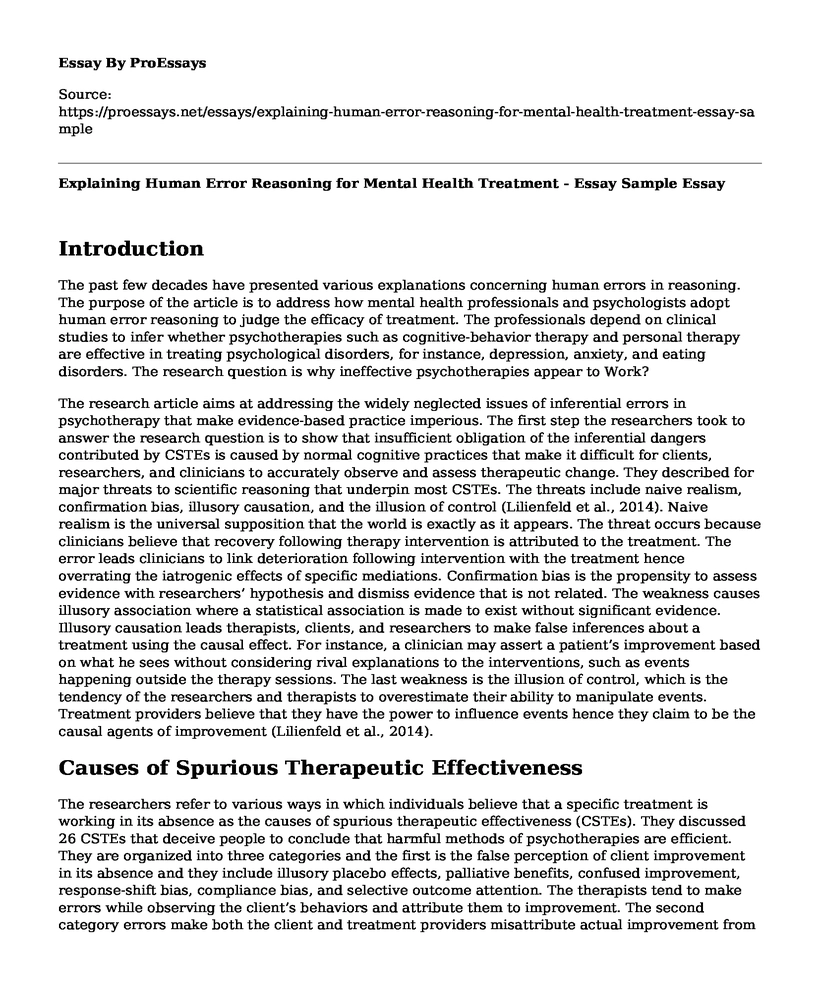Introduction
The past few decades have presented various explanations concerning human errors in reasoning. The purpose of the article is to address how mental health professionals and psychologists adopt human error reasoning to judge the efficacy of treatment. The professionals depend on clinical studies to infer whether psychotherapies such as cognitive-behavior therapy and personal therapy are effective in treating psychological disorders, for instance, depression, anxiety, and eating disorders. The research question is why ineffective psychotherapies appear to Work?
The research article aims at addressing the widely neglected issues of inferential errors in psychotherapy that make evidence-based practice imperious. The first step the researchers took to answer the research question is to show that insufficient obligation of the inferential dangers contributed by CSTEs is caused by normal cognitive practices that make it difficult for clients, researchers, and clinicians to accurately observe and assess therapeutic change. They described for major threats to scientific reasoning that underpin most CSTEs. The threats include naive realism, confirmation bias, illusory causation, and the illusion of control (Lilienfeld et al., 2014). Naive realism is the universal supposition that the world is exactly as it appears. The threat occurs because clinicians believe that recovery following therapy intervention is attributed to the treatment. The error leads clinicians to link deterioration following intervention with the treatment hence overrating the iatrogenic effects of specific mediations. Confirmation bias is the propensity to assess evidence with researchers’ hypothesis and dismiss evidence that is not related. The weakness causes illusory association where a statistical association is made to exist without significant evidence. Illusory causation leads therapists, clients, and researchers to make false inferences about a treatment using the causal effect. For instance, a clinician may assert a patient’s improvement based on what he sees without considering rival explanations to the interventions, such as events happening outside the therapy sessions. The last weakness is the illusion of control, which is the tendency of the researchers and therapists to overestimate their ability to manipulate events. Treatment providers believe that they have the power to influence events hence they claim to be the causal agents of improvement (Lilienfeld et al., 2014).
Causes of Spurious Therapeutic Effectiveness
The researchers refer to various ways in which individuals believe that a specific treatment is working in its absence as the causes of spurious therapeutic effectiveness (CSTEs). They discussed 26 CSTEs that deceive people to conclude that harmful methods of psychotherapies are efficient. They are organized into three categories and the first is the false perception of client improvement in its absence and they include illusory placebo effects, palliative benefits, confused improvement, response-shift bias, compliance bias, and selective outcome attention. The therapists tend to make errors while observing the client’s behaviors and attribute them to improvement. The second category errors make both the client and treatment providers misattribute actual improvement from extra therapeutic influences to the intervention offered. The factors influencing the client’s change may include life events that happen outside the therapy sessions. Some of the Category 2 CSTEs include maturation, history, errors in initial diagnosis, and regression to the mean after retesting.
Category 3 CSTEs also lead to misattribution of clients' change to the specific treatment when the change is caused by nonspecific effects, such as the provision of hope. Some of these errors include placebo and novelty effects where the client is expected to improve following the treatment. However, the improvement may be attributed to other factors that happen during therapy sessions, for example, motivation.
Conclusion
The researchers explain four major cognitive weaknesses that contribute to the inaccuracy improvement evaluation in psychotherapy and they include naive realism, confirmation bias, illusory causation, and the illusion of control. To respond to the research question, the researchers discuss 26 causes of spurious therapeutic effectiveness (CSTEs) that are classified into three classes. Although causality helps to make generalized inferences about the study population, and improved obligation of the inferential difficulties modeled by CSTEs may limit the study and evidence-based practice for methodological safeguards. Limitation of the study include the focus on the non-therapeutically factors that cause change to the clients without considering the role played by the treatment.
Reference
Lilienfeld, S. O., Ritschel, L. A., Lynn, S. J., Cautin, R. L., & Latzman, R. D. (2014). Why ineffective psychotherapies appear to work: A taxonomy of causes of spurious therapeutic effectiveness. Perspectives on Psychological Science, 9(4), 355-387. http://www.psyciencia.com/wp-content/uploads/2014/09/Why-Ineffective-Psychotherapies-Appear-to-Work-A-Taxonomy-of-Causes-of-Spurious-Therapeutic-Effectiveness-de-Scott-O.-Lilienfeld-et.al-2014.pdf
Cite this page
Explaining Human Error Reasoning for Mental Health Treatment - Essay Sample. (2023, Aug 28). Retrieved from https://proessays.net/essays/explaining-human-error-reasoning-for-mental-health-treatment-essay-sample
If you are the original author of this essay and no longer wish to have it published on the ProEssays website, please click below to request its removal:
- Global Happiness
- Juvenile Mental Health Court Recidivism Essay
- Adolescent Suicidal Behaviors Paper Example
- Research Paper on Homeless Individuals With Schizophrenia
- Paper Example on Behavioral Corporate Finance: Implications, Value-Based Mgmt & Psychology
- The Virgin Suicides: Secluded Lives in 1970s Detroit - Essay Sample
- Become a Teacher: Passion & Experience Teaching Children & Adults - Essay Sample







